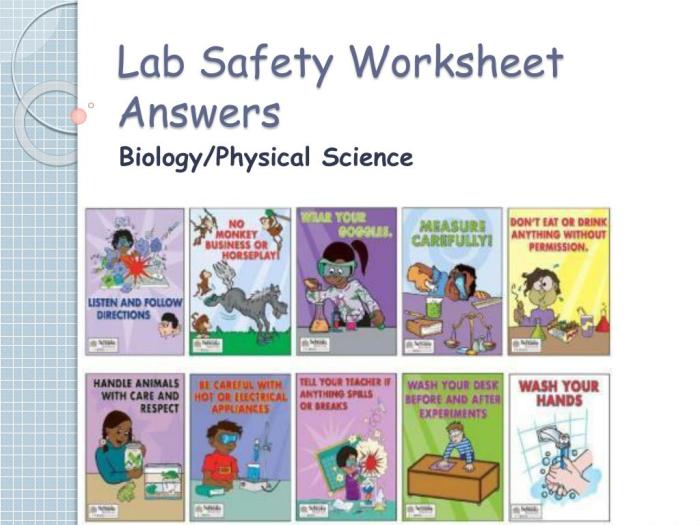Safety in the laboratory worksheet answers – Embark on a journey into the realm of laboratory safety with our comprehensive worksheet answers, meticulously crafted to guide you through the intricacies of laboratory protocols and best practices. This in-depth resource empowers you with the knowledge and understanding to navigate the laboratory environment with confidence and ensure your safety and the well-being of others.
Our worksheet answers delve into the core principles of laboratory safety, providing a thorough examination of potential hazards, essential personal protective equipment (PPE), and safe handling techniques for chemicals and equipment. We emphasize the importance of emergency preparedness and effective waste management practices, ensuring you are well-equipped to respond to any situation.
Laboratory Safety Protocols: Safety In The Laboratory Worksheet Answers

Adhering to laboratory safety protocols is paramount to ensuring a safe and productive work environment. These protocols establish guidelines and regulations that aim to minimize the risks associated with laboratory work and protect individuals from potential hazards.
Failure to comply with safety protocols can result in accidents, injuries, or even fatalities. Therefore, it is essential for laboratory personnel to understand and strictly follow these protocols at all times.
Potential Hazards and Risks
- Exposure to hazardous chemicals
- Electrical hazards
- Fire hazards
- Biological hazards
- Ergonomic hazards
Common Safety Rules and Regulations
- Wear appropriate personal protective equipment (PPE)
- Handle chemicals safely and properly
- Operate equipment cautiously and follow instructions
- Maintain a clean and organized work area
- Report any accidents or incidents immediately
Personal Protective Equipment (PPE)

Personal protective equipment (PPE) plays a crucial role in protecting laboratory personnel from potential hazards. Different types of PPE are designed to safeguard specific parts of the body from various risks.
Types of PPE
- Eye protection:Safety glasses or goggles
- Skin protection:Gloves, lab coats, aprons
- Respiratory protection:Respirators or masks
- Foot protection:Safety shoes or boots
Purpose and Function of PPE
Each type of PPE serves a specific purpose and function:
- Eye protection prevents chemical splashes or flying debris from entering the eyes.
- Skin protection shields the skin from contact with hazardous chemicals or biological agents.
- Respiratory protection filters out harmful fumes, vapors, or dust particles.
- Foot protection safeguards the feet from falling objects, spills, or sharp materials.
Proper Use of PPE, Safety in the laboratory worksheet answers
To ensure maximum protection, it is essential to wear and use PPE correctly:
- Select the appropriate PPE for the specific hazard.
- Inspect PPE before each use and replace any damaged items.
- Wear PPE at all times in designated laboratory areas.
- Dispose of PPE properly after use.
Chemical Safety
Handling and storing chemicals in the laboratory require utmost care and attention to ensure safety. Proper chemical management practices minimize the risks associated with hazardous substances.
Safe Handling of Chemicals
- Always read and understand the safety data sheet (SDS) for each chemical.
- Use chemicals only in well-ventilated areas.
- Handle chemicals with caution, avoiding spills or splashes.
- Dispose of chemicals properly according to established protocols.
Chemical Hazards and Mitigation
Chemicals pose various hazards, including:
- Toxicity:Harmful effects on the body
- Flammability:Risk of fire or explosion
- Reactivity:Potential for dangerous reactions
- Corrosivity:Damage to skin or tissues
To mitigate these hazards, implement measures such as:
- Proper ventilation
- Use of fume hoods
- Appropriate storage conditions
- Training and education
Chemical Safety Procedures
Established chemical safety procedures include:
- Proper disposal:Dispose of chemicals according to their specific requirements.
- Spill response:Have a plan in place to respond to chemical spills effectively.
- Emergency procedures:Know the emergency procedures in case of a chemical accident.
FAQ Guide
What are the most common laboratory hazards?
Common laboratory hazards include chemical spills, fires, explosions, biological agents, and electrical hazards.
What is the purpose of personal protective equipment (PPE) in the laboratory?
PPE protects laboratory personnel from exposure to hazardous materials and potential injuries. It includes items such as gloves, lab coats, safety glasses, and respirators.
How should chemicals be handled and stored in the laboratory?
Chemicals should be handled and stored according to their specific safety data sheets (SDSs). Proper storage includes using appropriate containers, labeling chemicals clearly, and storing them in designated areas.
What are the emergency procedures to follow in the event of a laboratory accident?
In the event of a laboratory accident, it is crucial to remain calm and follow established emergency procedures. These may include evacuating the area, notifying the instructor or supervisor, and seeking medical attention if necessary.
How can waste be disposed of safely in the laboratory?
Laboratory waste should be disposed of according to its classification as hazardous or non-hazardous. Proper disposal methods include incineration, chemical treatment, or disposal in designated waste containers.